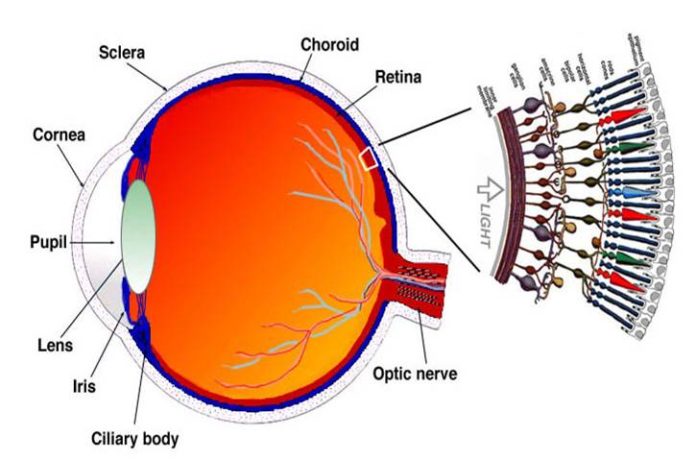
My mother-in-law texted me about The Dress, random friends are blowing up my inbox, and the nurses in the emergency department were huddled around the computer at 2 a.m. debating the color of the dress. Everyone in the world seems to be wondering what color the dress really is and why.
The best way to find the answer to such questions is to find an expert, and in this case, I found Matthew Weed, MD, an ophthalmologist and researcher at the University of Iowa who studies the genetics of inherited eye diseases and the interaction of light sensing cells inside the eye known as rods and cones. Sit back and read as Dr. Weed explains to us the truth behind the dress.
Is it white and gold? Or blue and black? Well, just like in kindergarten, we’re all winners, and it’s all because of the Purkinje effect. Understanding a little bit about how these cells work will help keep you from pulling your hair out or yelling at your spouse over the color of this dress.

Most of the inside of the eye is lined by a very thin multicellular structure called the retina, which is commonly likened to the film inside a camera. This is because it is the retina that senses the light focused by other eye structures, and cells within the retina then transmit this visual information via the optic nerve to the brain for additional processing.
First, a word about light. Visible light is made up of several different wavelengths, and these wavelengths correspond to different colors. When visible light is split into its different wavelengths, as with a prism or a rainbow, the different wavelengths/colors of light are visible.
The photoreceptor cells that actually detect the light — the rods and cones — lie within the outer layers of the retina. Cones work best in bright light, and allow us to see a wide range of color. Rods, by contrast, are maximally active in dim lighting conditions; the reason it takes a few minutes for your eyes to adjust to being in the dark is because your eye is activating its rods.
The actual molecules that sense light within the rods and cones are known as “opsins,” and there are four different types, each of which absorbs different wavelengths of light. The rods contain only one opsin (rhodopsin), which absorbs light with a wavelength of 500 nanometers. Light with this wavelength has a silvery, blue-green color, the color of moonlight. Because this is the only opsin working, the only color we can really see in dim light is this silvery, blue-green color. This is known as the Purkinje effect.

So what about the other three opsins? Unlike rods, there are actually three different types of cones, and each has a different opsin. Red cones absorb light best at 560 nanometers, green cones at 530 nanometers, and blue cones at 430 nanometers. In normal lighting conditions, it is the activation of a combination of these cones that allows you to see a wide range of different colors.
Before we move on to examine the dress photo, it’s important to understand that color vision isn’t an absolute thing, it’s a perception, meaning it requires the brain to process what the eye is seeing, and allows for different people to see the same object in different ways. This is why, regarding the color of this dress, I’m not interested in what the “actual” colors are, and more interested in why people can see the same thing different ways. I think both camps are right.

Knowing this, let’s consider the dress photo. The first thing to notice is that the dress is backlit, leaving the dress in shadow. Your brain is familiar with the Purkinje effect on a subconscious level, and it knows that in shadowy, dim lighting, white things often look silvery blue. If your brain has decided to perceive this image primarily as dimly-lit, you subconsciously cancel out the bluish tinge of the dress and see the white. A similar effect happens with the gold-or-black panels on the dress. Look at the center part of the top gold-or-black panel, where it’s a bit lighter. This part looks extremely gold to some people, but shiny black to others. If you are subconsciously adjusting for the poor lighting, you perceive this as gold; if not, it looks like a sheen or light reflection on black.
So why are a lot of people noticing the image flipping back and forth between the colors? I believe that this has to do with the dark- or light-adapted state of the eye. If you’re having a tough time seeing it the other way, there are several things you can do to try to alter your perception. First, try sitting in a dark room for 20 to 30 minutes, and then look at the image again. Then, go out in bright light, and take another look. Second, try squinting, which will allow less light into the eye and serve as a mini-dark adaptation and make the dress look black and blue. Third, try covering up the bright lighting on the right side of the image. Fourth, try playing with the brightness settings on your phone.
Finally, let’s dispel a myth. You might have heard that the reason for the discrepancy between the color perception has to do with the emotional state of the viewer. I believe this to be complete bunk.
In the end, it doesn’t really matter what the “true” color of the dress is. The whole point is that under the lighting conditions in the photo, people can perceive either black and blue or gold and white, and neither is necessarily more correct than the other, because of the Purkinje effect.
Steve Christiansen is an ophthalmology resident who blogs at EyeSteve, where this article originally appeared. He can be reached on Twitter @EyeSteve.
